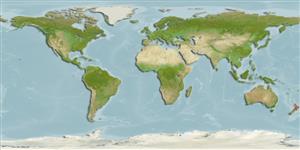Common names from other countries
Environment: milieu / climate zone / depth range / distribution range
Écologie
marin démersal; profondeur 10 - ? m. Temperate; 29°S - 45°S, 144°E - 175°W
Southwest Pacific: New Zealand and southern Australia.
Length at first maturity / Taille / Poids / Âge
Maturity: Lm ?, range 40 - ? cm
Max length : 80.0 cm FL mâle / non sexé; (Ref. 13700); common length : 63.0 cm TL mâle / non sexé; (Ref. 9258); âge max. reporté: 33 années (Ref. 12155)
Most adults form school offshore over mainly open bottom. Some adults do not school but remain around reefs. Juveniles occur inshore, usually around rocky reefs.
Life cycle and mating behavior
Maturité | Reproduction | Frai | Œufs | Fécondité | Larves
Paulin, C., A. Stewart, C. Roberts and P. McMillan, 1989. New Zealand fish: a complete guide. National Museum of New Zealand Miscellaneous Series No. 19. 279 p. (Ref. 5755)
Statut dans la liste rouge de l'IUCN (Ref. 130435)
CITES (Ref. 128078)
Not Evaluated
Menace pour l'homme
Harmless
Utilisations par l'homme
Pêcheries: commercial; pêche sportive: oui
Plus d'informations
CollaborateursImagesStamps, Coins Misc.SonsCiguateraVitesseType de nageSurface branchialeOtolithesCerveauxVision
Outils
Articles particuliers
Télécharger en XML
Sources Internet
Estimates based on models
Preferred temperature (Ref.
115969): 14.9 - 21.4, mean 17.6 (based on 22 cells).
Phylogenetic diversity index (Ref.
82804): PD
50 = 0.7812 [Uniqueness, from 0.5 = low to 2.0 = high].
Bayesian length-weight: a=0.01950 (0.00827 - 0.04596), b=2.97 (2.76 - 3.18), in cm Total Length, based on LWR estimates for this species & (Sub)family-body (Ref.
93245).
Niveau trophique (Ref.
69278): 3.3 ±0.0 se; based on diet studies.
Résilience (Ref.
120179): Faible, temps minimum de doublement de population : 4,5 à 14 années (K=0.21; tm=5-6; tmax=33).
Fishing Vulnerability (Ref.
59153): Moderate to high vulnerability (51 of 100).
